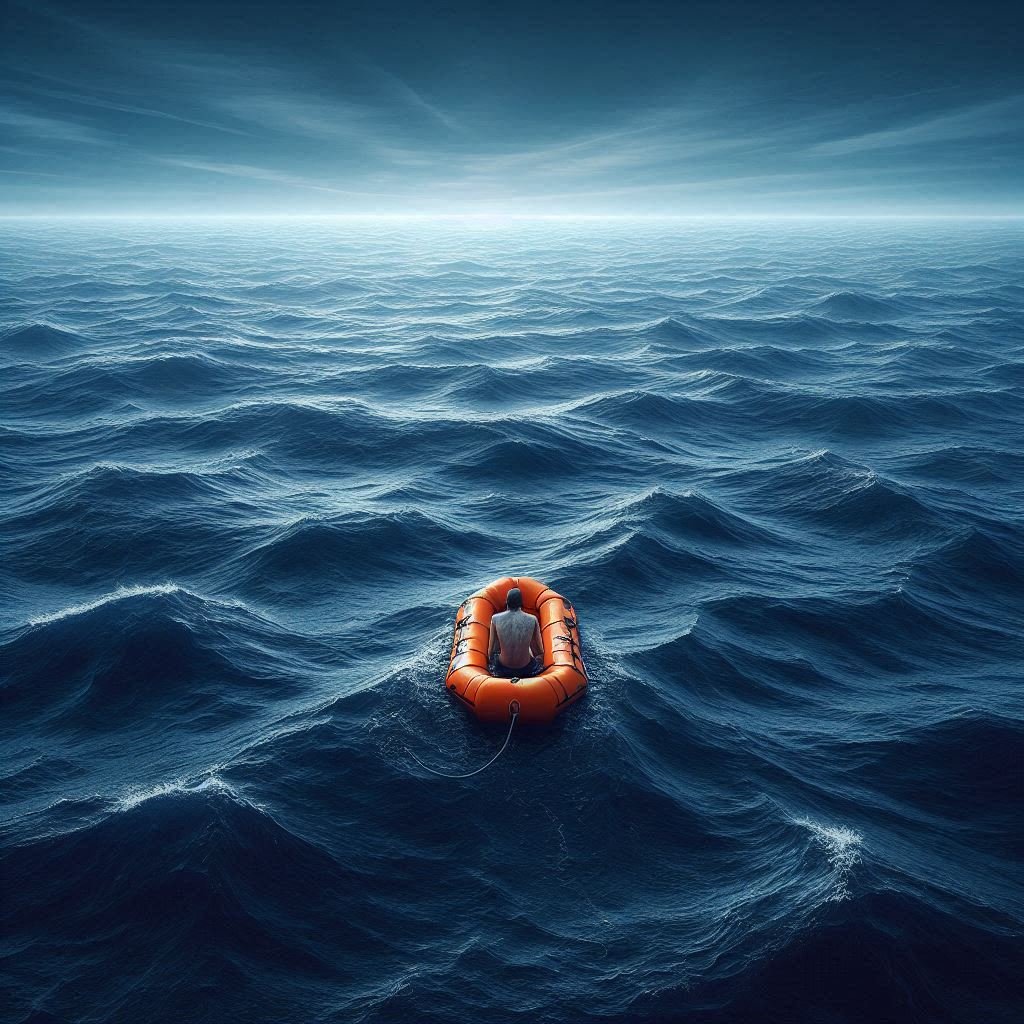Listen to “Unbelievable True Story of Steve Callahan's Ocean Survival” on Spreaker.
Picture this.
It’s the middle of the Atlantic Ocean. Everywhere you look—water. Blue, endless, stretching out so far it almost feels like the horizon is laughing at you, daring you to find land.
Now, floating in the middle of all that water is a tiny inflatable raft, no bigger than a small car. Inside that raft sits one man. He’s sunburned, starving, weak, and completely alone. His boat is gone, swallowed by the ocean. His supplies? Almost gone. His only chance of survival? His own willpower.
This is the true story of Steve Callahan, a man who spent 76 days adrift at sea. And the way he survived—it’s not just impressive. It’s borderline impossible.
A Dream Voyage
Let’s rewind.
The year is 1981. Steve Callahan is 29 years old. By trade, he’s a naval architect—which basically means he designs boats. But his real passion is sailing. Steve is one of those people who doesn’t just dream about adventure—he builds it with his own two hands.
For years, Steve worked on a boat he designed himself, a 31-foot sloop he proudly named Napoleon Solo. To him, this wasn’t just wood, fiberglass, and sails. This was a piece of his soul, a floating extension of who he was.
The plan? Take Napoleon Solo on the adventure of a lifetime. First stop: sail from Rhode Island to Bermuda. Then, hop through the Caribbean. And after that—tackle the Atlantic Ocean and cross all the way to Europe.
It wasn’t a crazy idea. Steve knew what he was doing. He wasn’t reckless. His boat was well-built, he had survival gear, and he had the kind of calm, calculating brain you need if you’re going to take on the ocean by yourself.
So when Steve set sail, he felt ready. Excited. Nervous, sure, but in the good way.
And at first, everything went according to plan.
The trip to Bermuda? Smooth. The time in the Caribbean? Paradise. But then came the real test: that massive Atlantic crossing. That’s when his dream turned into something else. Something darker.
Disaster in the Night
It’s February 4th, 1982. Steve is 800 miles west of the Canary Islands, right in the middle of the Atlantic. The weather isn’t great. A storm has been building, tossing Napoleon Solo around.
Steve, exhausted, goes below deck to try to rest. But just before dawn, he’s jolted awake. The boat shakes violently, almost like it hit a wall. Then comes the sound every sailor dreads—water rushing in. Fast.
Something, maybe a whale or a massive chunk of debris, has slammed into Napoleon Solo, ripping a hole straight through her hull. Within seconds, the boat is taking on water, sinking right beneath him.
Steve scrambles. He knows he has no time. He grabs his emergency ditch bag—a small waterproof kit filled with survival essentials—and throws his life raft overboard. Then, with the water rising, he abandons Napoleon Solo.
Imagine that moment. The boat you spent years building, the one you trusted with your life, is disappearing beneath the waves. And now it’s just you, sitting in a flimsy inflatable raft, bobbing on the swells like a bathtub toy.
That’s where Steve found himself. And the reality was terrifying: the Atlantic Ocean is over 40 million square miles. He was a single human being, floating in the middle of it.
Alone on the Raft
The raft was small—just six feet across. Barely enough space to stretch his legs. Inside, Steve took stock of what he had:
-
A small solar-powered desalinator (to turn saltwater into drinkable water).
-
A fishing spear and some hooks.
-
A little bit of food rations.
-
A flare gun.
-
A knife.
-
Some patch kits for the raft.
That was it.
At first, Steve told himself he’d be rescued soon. Maybe a passing ship would spot him. Maybe he’d drift into shipping lanes. He had flares, after all. He had signaling gear. He just needed to hold on.
But the truth? He was nowhere near shipping routes. His raft was nearly invisible from a distance. And the Atlantic doesn’t care about your timeline.
Days turned into weeks. Weeks into months. And Steve was forced to learn the hardest lesson of his life: if he wanted to survive, it would be up to him, and him alone.
The Battle for Water
The first problem: fresh water. Humans can only survive about three days without it.
Steve’s solar-powered desalinator worked… but very slowly. It produced just a trickle of water each day. So he became obsessed with rain. Whenever a storm rolled in, he spread out anything he had—plastic sheets, fabric, even parts of the raft—to collect drops. Every cup he managed to save felt like treasure.
Sometimes, storms brought him salvation. Other times, weeks went by under a blazing sun, with not a single cloud. His lips cracked, his throat burned, his body shriveled from dehydration.
But he never gave up. Every drop counted.
Hunting the Ocean
The second problem: food.
Steve’s emergency rations ran out quickly. After that, he had to rely on the ocean itself. At first, he struggled. Spearing fish from a bobbing raft isn’t easy. But eventually, he noticed something strange: little fish liked to gather under his raft, using it as shade from predators.
That was his opening. He caught those little fish, then used them as bait for bigger ones. Slowly, he taught himself to reel in mahi-mahi, triggerfish, even the occasional small shark.
He ate every part he could stomach—even the fish eyes—for precious nutrients. Sometimes he dried strips of fish in the sun to make jerky, saving it for later.
But every meal was a fight. The ocean wasn’t just generous; it was cruel too. Sharks circled his raft, smelling blood. More than once, they lunged at his catches, ripping them away before he could eat. His raft, fragile and inflatable, always at risk of being punctured.
Still, he adapted. The raft became its own tiny ecosystem. The fish brought more fish. And Steve, gaunt and sunburned, became part of the food chain himself—hunter, scavenger, survivor.
Storms, Sharks, and False Hope
If you think drifting in a raft is boring—think again. The ocean threw everything at him.
Massive storms pummeled the raft, flipping it over like a toy. Steve had to cling desperately, bailing out water, terrified the raft would collapse for good. Lightning lit up the sky while waves crashed down, threatening to swallow him.
Then there were the false rescues. More than once, Steve saw ships on the horizon. Huge tankers or freighters. He fired flares. He waved frantically. But the ships never saw him. They just kept moving, disappearing into the distance, leaving him crushed.
He later admitted those moments nearly broke him. Being so close to salvation, only to lose it—it was torture.
And always, the sharks. Dark fins circling. Sometimes bumping the raft. Sometimes staring at him with cold, black eyes. They were a constant reminder that he wasn’t just fighting the ocean. He was living in it.
Body and Mind Breaking
As the days stretched into months, the toll on Steve’s body was brutal.
He lost over 40 pounds. His skin broke out in saltwater sores. His teeth loosened from malnutrition. His gums bled. His body became skeletal, weak, and fragile.
Mentally, he fought battles just as fierce. Hallucinations. Crushing loneliness. The temptation to just… stop.
But every time, he forced himself to keep going. He talked to himself. He kept a journal. He clung to tiny routines—checking his desalinator, cleaning fish, patching the raft—as a way to stay sane.
And somehow, against all odds, he kept going.
Land at Last
By March of 1982, Steve had been drifting for over two months. Seventy-five days.
Then he noticed something different. The swells of the open ocean felt… different. The birds around him looked different too. Land birds.
That could only mean one thing: he was drifting toward land.
On day 76, he saw it. A dark line on the horizon. An island. Real, solid land. For the first time in months, the nightmare was ending.
But he wasn’t safe yet. He still had to get help. And he was almost too weak to move.
That’s when three fishermen spotted him. At first, they thought the raft was just debris. Then they saw the skeletal man inside, waving with the last of his strength.
They pulled him aboard, and just like that—his ordeal was over.
Recovery and Legacy
When he was rescued, Steve weighed just 95 pounds. His body was covered in sores. He was dehydrated, malnourished, barely alive. Doctors called his survival a miracle.
But survive he did. And later, he wrote his story in a book called Adrift: Seventy-Six Days Lost at Sea, which became a survival classic.
Steve didn’t just prove what humans are capable of. He showed the world what sheer determination, ingenuity, and willpower can do—even against impossible odds.
Because the truth is, the Atlantic didn’t spare him. He fought for every single day he got. And he won.
Final Thought
So that’s the story of Steve Callahan—the man who stared down the Atlantic Ocean for 76 days and lived to tell about it.
But here’s the question I want to leave you with:
Do you think survival in a situation like this comes down more to skill… or to mental toughness?
Let me know what you think.
And until next time—stay curious, because the world is full of strange, dark, and mysterious stories.




